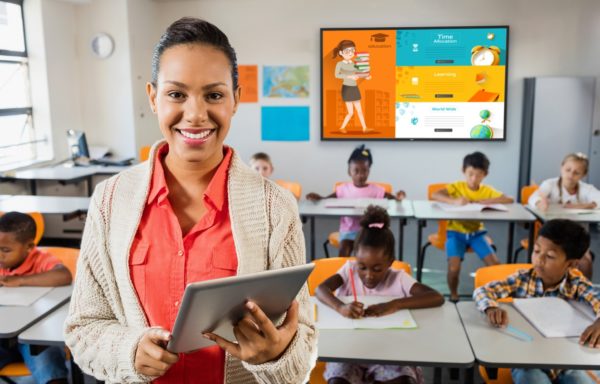It’s no secret that 21st century teachers and school administrators are under enormous pressure to differentiate instruction to enhance learning for all students, regardless of ability or their innate interest in the material. The modern classroom is an increasingly diverse place, so it can feel more challenging than ever to reach every student.
Enter classroom learning centers. Although elementary school teachers have long been familiar with learning centers as a way to provide different activities for literacy and math, learning centers are becoming more popular in middle and high schools as a way to differentiate learning and keep students more engaged than they would be with an endless stream of traditional lecture-based lessons.
Instead of orienting a classroom to have all student desks facing a whiteboard at the front of the room, a flexible learning center model often includes modular workstations where students can break into groups as well as quiet spaces for individual study. Large tables and several display areas provide the flexibility to convene large and small groups throughout the day, depending on the goal of the lesson and the needs of individual students.
Technology: The Key Ingredient in Successful Learning Centers
Although the classic literacy or math center takes time to organize physically in the classroom, technology makes it easy for students to get to work quickly. A large screen display or desktop monitor ensures everyone in the group can see the material easily, and individual touch screens allow students to complete assignments at their own pace and submit them to the teacher electronically or for everyone else to see.
Classroom technology also makes it easier than ever to differentiate lessons appropriately. For example, the teacher can divide students into groups based on skill and tailor mini-lessons in centers based on what students need to practice. Software focused on personalized learning can also adapt to individual student needs and allow teachers to track their progress.
With individual devices, students can work at their own paces and always have something to do, ending the boredom of waiting for others to catch up or the frustration of falling behind.
What’s more, integrating technology into the classroom allows schools to meet Common Core standards about technology and digital media literacy [1]. For example, the standards recommend that students be able to use technology independently, a skill they practice in learning centers while they study everything from Shakespeare to geometry [2].
Because technology is such an integral part of the modern world, the days of spending a few hours in the computer lab are long past: Today’s students need complete access to the internet and the hardware they’ll be expected to use in the real world.
Collaboration technology is quickly becoming an integral part of education, enabling teachers and students to take work created by different groups on multiple devices and share it with the entire class on the classroom’s main display, whether it’s a projector or a large screen display.
(Next page: 5 technologies for engaging learning centers)
How to Integrate Technology into the Modern Classroom
Above all, the 21st-century classroom requires a flexible layout that allows teachers to group students in a variety of ways. This means that furniture should allow for several layouts, and technology should be equally portable. A range of solutions will provide the most flexibility for teachers and students alike:
- Projectors. Teachers can save time by making slide shows and gathering display materials ahead of time and broadcast them to the whole classroom without having to turn their back to students. High-definition images and full teacher attention on the class increases engagement and helps streamline both classroom management and learning.
- Interactive White Boards. Today’s students are used to interacting with technology in their daily lives, so their expectations are high. Interactive white boards or touchscreens allow teachers to deliver engaging whole-class lessons and provide a place for students to share ideas. Interacting with in-the-moment surveys and assessment provides instant feedback to teachers and keeps things fun for students.
- Desktop Monitors. Several workstations with desktop monitors allows groups of students to gather to work together on the same topic. This equipment stands up to the demands of many hands and is perfect for internet research and practicing skills via dedicated software.
- Large Screen Displays. Crisp displays are sharp enough to show every detail of an image or video, which lets teachers bring the best media from around the world to their students. Touch-integrated screens allow for up-to-date multimedia presentations for both students and teachers. Hang one opposite the main projector to create two separate learning areas.
- Individual Devices. Tailor learning and assessment to the individual with handheld devices. Use them to deliver a quiz via touchscreen, provide individualized passages to an e-reader or encourage student collaboration by connecting devices to a smart board at the front of the room. These devices can be used in groups or wherever students gather in the classroom.
- Interactive Technologies. Get the most out of individual devices by connecting them via hardware/software integrating programs like NEC’s DisplayNote or MultiPresenter to share information and collect work on a single screen. Collaborative displays also allow for sharing computers and devices like Raspberry Pi across the classroom to take brainstorming and group work to a new level.
With smart technology integrated into the classroom, students benefit equally from independent and collaborative learning. Teachers can reach individual needs while tracking progress with ease. When learning centers are enhanced with the right technology, a wide world of learning is opened to all.
NEC has been developing visual products with schools in mind for years, offering complete classroom solutions that include displays, software, and touch overlays and other peripherals. These solutions make adding technology to the classroom easier than ever.
